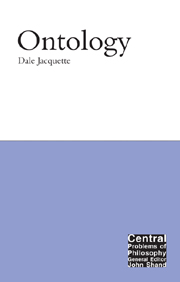Book contents
- Frontmatter
- Contents
- Preface
- Acknowledgements
- Introduction: Being as such
- I Pure philosophical ontology
- II Applied ontology and the metaphysics of science
- 6 Ontological commitment (on Quine)
- 7 Appearance, reality, substance, transcendence
- 8 Physical entities: space, time, matter and causation, physical states of affairs and events, natural laws
- 9 Abstract entities, particular and universal: numbers, sets, properties, qualities, relations, propositions and possibilities, logical, mathematical and metaphysical laws
- 10 Subjectivity of mind in the world of objective physical facts
- 11 God, a divine supernatural mind?
- 12 Ontology of culture: language, art and artefacts
- Conclusion: scientific–philosophical ontology
- Notes
- Bibliography
- Index
12 - Ontology of culture: language, art and artefacts
from II - Applied ontology and the metaphysics of science
- Frontmatter
- Contents
- Preface
- Acknowledgements
- Introduction: Being as such
- I Pure philosophical ontology
- II Applied ontology and the metaphysics of science
- 6 Ontological commitment (on Quine)
- 7 Appearance, reality, substance, transcendence
- 8 Physical entities: space, time, matter and causation, physical states of affairs and events, natural laws
- 9 Abstract entities, particular and universal: numbers, sets, properties, qualities, relations, propositions and possibilities, logical, mathematical and metaphysical laws
- 10 Subjectivity of mind in the world of objective physical facts
- 11 God, a divine supernatural mind?
- 12 Ontology of culture: language, art and artefacts
- Conclusion: scientific–philosophical ontology
- Notes
- Bibliography
- Index
Summary
Cultures and cultural objects
We turn finally to the topic of cultural entities. The world contains not only natural objects like rocks and plants, but objects that would not exist as complexes or in the exact form with the particular properties they have were it not for human intervention. There are artefacts, products of human thought that are touched and transformed in various ways by human hands. The list of such things includes expressions of thought in language and art, and all the results of human invention, manufacture and technology.
It may be significant, in this study of combinatorial ontology, an expressly anti-Heideggerean anti-existentialist theory of being, that we should end up where Heidegger, relying on phenomenology rather than logic as the key to ontology, finds it necessary to begin. We conclude the analysis of applied scientific ontology in effect with a discussion of Zuhandenheit and the impact of human intention and activity that shapes and colours the world in a distinctively human way.
The applied ontology of cultural entities that we shall sketch for simplicity is limited to human culture. We should recognize at the same time that other terrestrial non-human animals also have more restricted social cultures, and in less extensive ways also change their environments by making artefacts and assembling composite entities out of available materials to suit their needs. A nest in a tree, damming a river to make a lodge, even a tunnel in the earth, are cultural artefacts of a crude sort.
- Type
- Chapter
- Information
- Ontology , pp. 265 - 274Publisher: Acumen PublishingPrint publication year: 2002



